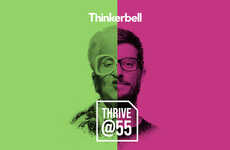
References: adsoftheworld
As the Founder and Editor of Ads of the World, Ivan Raszl knows the importance of spotting trends. The Ads of the World archive and community features advertisements from around the world, and Ivan Raszl is himself quite worldly.
Living in Hungary, Ivan Raszl speaks English, Hungarian and Russian fluently. He spoke to us about his work and the role trend spotting plays in it.
12 Questions with Ivan Raszl
1. How did you get involved with Ads of the World and what motivates you to continue?
I started Ads of the World because I could not find a free and organized library of creative advertisements that would allow me to learn and get inspired efficiently. So, first I decided to do a library just for personal use. Then I opened it up for the public.
Eventually the library transformed into an online community, so it was less about research and more about socializing. Encouragements from readers keep me highly motivated to keep making it better.
2. How significant are the topics of trend spotting to Ads of the World?
Advertising is mass consumed art with a purpose. Successful campaigns always ride popular trends and in some cases create new trends. Understanding trends is therefore essential to every advertising professional.
3. How do you define a trend?
A trend is a social wave that is defined by an underlying philosophy. This philosophy usually goes undetected by the public, but it gives trends the stability for mid or long term success.
For example Nike’s ‘Just do it’ campaign subconsciously urges people to embrace individualism against altruism. People embrace it because they intrinsically feel it is the right attitude to life.
4. How do you define cool?
Being cool is following a popular trend within a social group.
5. Do you need a culture of innovation to create something that is cool?
No, you don’t necessarily need to innovate. There are recurring trends that tend to become cool from time to time.
If you want to innovate, live with a special attention to insights and opportunities. An idea can come from anywhere. Unfortunately whatever you come up with it’s highly likely that you are not the first one to invent it. But don’t worry too much about it.
Your new idea in combination with your own uniqueness will create a cool combination that given exposure at least a few from the 7 billion people on the planet will appreciate.
6. What is the best way to create an infectious idea, product or service?
This is the million dollar question. Unfortunately I don’t know the definite answer that works every time. Being able to predict trends is certainly important. Shocking, lame or cute themes work most of the time.
7. What is the key to innovation?
Identifying the problem or asking the right question is the key. If you live with your eyes open and do not accept routine you will be able to question everything from everyday products to million dollar business models.
For example, eating pasta is rather inconvenient and dangerous if you wear a white shirt. Why do people put up with this problem for centuries? If you can identify the right question to ask around this simple issue you will almost automatically come up with an innovation that will change the life of millions overnight.
You should also train yourself to mentally force unrelated things together, because that’s what creative innovation is usually all about.
For example you take news and toilet paper and come up with a device that prints RSS feeds on toilet paper automatically so there is something to read while sitting on the loo.
8. What is the most important trend you see in your industry?
1. Stealth advertising. The effectiveness of traditional advertising is steadily declining. Magazines, newspapers and TV channels are closing down for lack of interest and revenue from advertising. Outdoor and radio is still hanging on, but not for long. You no longer can involve people in your brand with a press campaign.
People are fed up with ads. Advertisers have to find non-traditional ways to be able to communicate to their audience. Your communication has to stay under the radar.
User generated content and other decentralized communication is on the rise. Virals, ambients, online activations and most importantly media-hacks (creating news stories that get reported in media and indirectly promote a product or service) are a good way to involve consumers.
2. Advertainment. Entertainment traditionally was created by artists and later sponsored by companies. In the near future it will be created entirely from marketing budgets of large brands.
Boy bands will be created to sell product lines to teen girls. TV shows will be created entirely by car companies. This isn’t sponsorship anymore, the brands will create our pop culture almost exclusively.
3. Laser targeted advertising. In the past, creative briefs tried to include everybody as target market of a certain product or service. However marketers slowly realized that by trying to talk to everybody they are actually addressing nobody.
Highly sophisticated models for identifying the most valuable target that influences the most people within a population are being developed and used to create campaigns by advertising agencies. This is advertising that talks to a very narrow target at a very specific time about a very specific thing.
9. What are your ambitions for Ads of the World?
So far Ads of the World exceeded my expectations tenfold. We are now the top read advertising showcase and community. The whole graphics.com network that includes AdsoftheWorld.com and BrandsoftheWorld.com generate 40 million page views from 4 million unique visitors a month.
There is always room for improvement and the site is constantly in development. Readers send us great ideas on how the site can be improved. I take notes and add my own ideas.
My ambition is to create a site that is worth checking out at least once a week for every advertising professional in the world.
10. How do you reset yourself to be creative? (e.g. do you have any rituals, do you set aside time for creativity, etc.)
The short answer is to get new active experiences. Relaxing won’t do unless you’re sleep deprived. I think a lot about this subject and I share my tips on my blog. In this latest article I talk about what to eat to be creative. In an earlier article I gave 77 ways to kick-start your creativity when you feel burned out.
11. Professionally, what do you want to be doing in 10 years?
Ha-ha, I don’t want to work in 10 years. But to answer seriously, I want to be a consultant in the creative industry. I want to help businesses decide where to put their investments in the current creative, social and business environment.
I want to give ideas for new businesses and help to set them up. I do that to some extent already but hopefully I can do this exclusively within 10 years
12. What are your most important hobbies?
Traveling, sports, reading and talking. Most of my free time is spent with my beautiful wife and daughter.
Living in Hungary, Ivan Raszl speaks English, Hungarian and Russian fluently. He spoke to us about his work and the role trend spotting plays in it.
12 Questions with Ivan Raszl
1. How did you get involved with Ads of the World and what motivates you to continue?
I started Ads of the World because I could not find a free and organized library of creative advertisements that would allow me to learn and get inspired efficiently. So, first I decided to do a library just for personal use. Then I opened it up for the public.
Eventually the library transformed into an online community, so it was less about research and more about socializing. Encouragements from readers keep me highly motivated to keep making it better.
2. How significant are the topics of trend spotting to Ads of the World?
Advertising is mass consumed art with a purpose. Successful campaigns always ride popular trends and in some cases create new trends. Understanding trends is therefore essential to every advertising professional.
3. How do you define a trend?
A trend is a social wave that is defined by an underlying philosophy. This philosophy usually goes undetected by the public, but it gives trends the stability for mid or long term success.
For example Nike’s ‘Just do it’ campaign subconsciously urges people to embrace individualism against altruism. People embrace it because they intrinsically feel it is the right attitude to life.
4. How do you define cool?
Being cool is following a popular trend within a social group.
5. Do you need a culture of innovation to create something that is cool?
No, you don’t necessarily need to innovate. There are recurring trends that tend to become cool from time to time.
If you want to innovate, live with a special attention to insights and opportunities. An idea can come from anywhere. Unfortunately whatever you come up with it’s highly likely that you are not the first one to invent it. But don’t worry too much about it.
Your new idea in combination with your own uniqueness will create a cool combination that given exposure at least a few from the 7 billion people on the planet will appreciate.
6. What is the best way to create an infectious idea, product or service?
This is the million dollar question. Unfortunately I don’t know the definite answer that works every time. Being able to predict trends is certainly important. Shocking, lame or cute themes work most of the time.
7. What is the key to innovation?
Identifying the problem or asking the right question is the key. If you live with your eyes open and do not accept routine you will be able to question everything from everyday products to million dollar business models.
For example, eating pasta is rather inconvenient and dangerous if you wear a white shirt. Why do people put up with this problem for centuries? If you can identify the right question to ask around this simple issue you will almost automatically come up with an innovation that will change the life of millions overnight.
You should also train yourself to mentally force unrelated things together, because that’s what creative innovation is usually all about.
For example you take news and toilet paper and come up with a device that prints RSS feeds on toilet paper automatically so there is something to read while sitting on the loo.
8. What is the most important trend you see in your industry?
1. Stealth advertising. The effectiveness of traditional advertising is steadily declining. Magazines, newspapers and TV channels are closing down for lack of interest and revenue from advertising. Outdoor and radio is still hanging on, but not for long. You no longer can involve people in your brand with a press campaign.
People are fed up with ads. Advertisers have to find non-traditional ways to be able to communicate to their audience. Your communication has to stay under the radar.
User generated content and other decentralized communication is on the rise. Virals, ambients, online activations and most importantly media-hacks (creating news stories that get reported in media and indirectly promote a product or service) are a good way to involve consumers.
2. Advertainment. Entertainment traditionally was created by artists and later sponsored by companies. In the near future it will be created entirely from marketing budgets of large brands.
Boy bands will be created to sell product lines to teen girls. TV shows will be created entirely by car companies. This isn’t sponsorship anymore, the brands will create our pop culture almost exclusively.
3. Laser targeted advertising. In the past, creative briefs tried to include everybody as target market of a certain product or service. However marketers slowly realized that by trying to talk to everybody they are actually addressing nobody.
Highly sophisticated models for identifying the most valuable target that influences the most people within a population are being developed and used to create campaigns by advertising agencies. This is advertising that talks to a very narrow target at a very specific time about a very specific thing.
9. What are your ambitions for Ads of the World?
So far Ads of the World exceeded my expectations tenfold. We are now the top read advertising showcase and community. The whole graphics.com network that includes AdsoftheWorld.com and BrandsoftheWorld.com generate 40 million page views from 4 million unique visitors a month.
There is always room for improvement and the site is constantly in development. Readers send us great ideas on how the site can be improved. I take notes and add my own ideas.
My ambition is to create a site that is worth checking out at least once a week for every advertising professional in the world.
10. How do you reset yourself to be creative? (e.g. do you have any rituals, do you set aside time for creativity, etc.)
The short answer is to get new active experiences. Relaxing won’t do unless you’re sleep deprived. I think a lot about this subject and I share my tips on my blog. In this latest article I talk about what to eat to be creative. In an earlier article I gave 77 ways to kick-start your creativity when you feel burned out.
11. Professionally, what do you want to be doing in 10 years?
Ha-ha, I don’t want to work in 10 years. But to answer seriously, I want to be a consultant in the creative industry. I want to help businesses decide where to put their investments in the current creative, social and business environment.
I want to give ideas for new businesses and help to set them up. I do that to some extent already but hopefully I can do this exclusively within 10 years
12. What are your most important hobbies?
Traveling, sports, reading and talking. Most of my free time is spent with my beautiful wife and daughter.
Trend Themes
1. Stealth Advertising - Non-traditional ways of advertising through virals, ambients, online activations, and media-hacks.
2. Advertainment - Creating entertainment using marketing budgets of large brands like TV shows, music bands, movies.
3. Laser Targeted Advertising - Advertising to highly specific target markets that have a greater influence on population.
Industry Implications
1. Marketing and Advertising - Innovative and creative advertising that is non-traditional and personalized.
2. Entertainment - Creating new forms of entertainment using marketing budgets.
3. Technology - Use of highly sophisticated models to narrow the target market for a specific product or service.
5.5
Score
Popularity
Activity
Freshness























